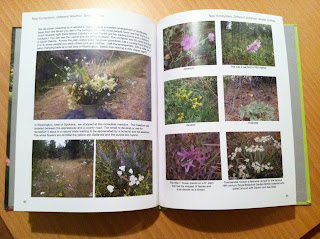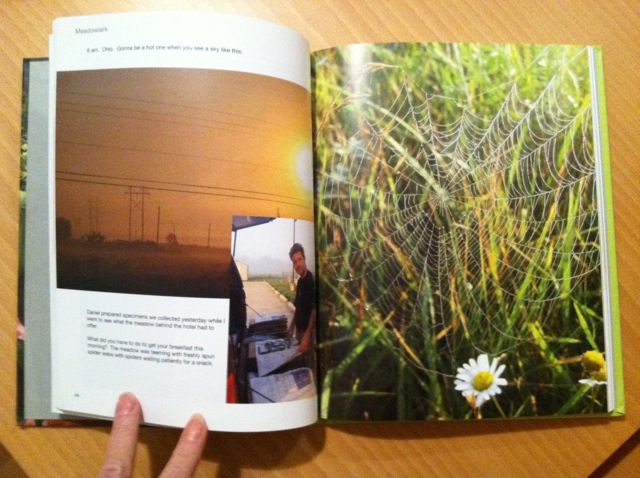 |
| It was a good year in Texas for wildflowers |
 |
| Marie's boots after a day in the field |
Daniel and I have returned from a week of collecting in Texas. Final tally was about 250 specimens, most of them unique -- very few duplicates. Texas offered such an amazing display of diverse flora everywhere we went.
We started out renting an RV. Daniel has long been dreaming about having some kind of Roving Botany Van and I have been fantasizing about chucking everything and hitting the road. So renting this gave both of us real world experience by which to gauge the sense of our fantasies. If you are on Daniel's contact list you already know that as soon as he got home he went on eBay and found a cute vintage trailer and "won" it. Daniel will use it all season, from Maine to the Carolinas and Florida. I hope to join him on some trips as work allows.
 |
| Roving Botany Van |
 |
| Stinky! |
Our rented RV was spacious and well equipped with a shower, toilet, three burner gas stove, sink and microwave. It also had heat and A/C but we didn't use them. Before hitting the road we stopped at the fabulous Central Market in Austin and stocked up on food and did eat from the RV most meals. Worked out fine. It was so convenient to be able to stop when and where we wanted. We stayed in state parks instead of Motel 6. The on board toilet was great. No more peeing in roadside weeds for me! Emptying the holding tank was not so much fun, but pretty easy (according to Daniel.)
Our first night in the Austin area we stayed with friends Miriam and Jimmy at the Little Buckaroo Ranch. They have over 100 animals and specialize in authentic Texas parties and events as well as horsemanship for kids. It's a great place, really beautiful and not Disney-fied. The real thing. Miriam showed me Pig Lee Wiggly's favorite scratching spot.

We went out to dinner with Jimmy, Miriam and Daniel's mom Ellen for a real Texas barbecue at the famous Salt Lick.
In the morning the moon set over the ranch as the sun came up and the round of chores began.

Before we headed west the next day we made a lunch of foods foraged on the ranch. These included stuffed fig leaves and a foraged salad with an agarita berry dressing. And one dish I won't mention because we did not like it at all! :-(
 |
| Fig leaves stuffed with wild onions and wild rice (store bought) |
 |
| Foraged salad with agarita berry and honey dressing |
Agarita bushes are all over the place. They have edible berries and medicinal roots.
 |
| Agarita |
 |
 We stayed a few days in the Garner State Park and made day trips from there. It was practically deserted so we were able to get a site right on the Rio Frio. The Rio Frio is a spring fed river so it is always cool, clean, and clear.
We stayed a few days in the Garner State Park and made day trips from there. It was practically deserted so we were able to get a site right on the Rio Frio. The Rio Frio is a spring fed river so it is always cool, clean, and clear.
We relaxed in hammocks that Daniel hung for us. You can see how empty the park is. We were told that for the weekend, every spot would be filled.
The river bed was all smooth with round river stones. There were trout too. There were wildflowers amidst the beach rocks but we did not collect in the park.
After Garner we stayed at an RV park on the Guadalupe River. The owner gave us carte blanche to collect there. It was a pretty camp and nearly empty as well.
The flowers all over were amazing this year compared to last April. Last year we made one stop by a road to look at a single wine cup that was four inches tall. I oohed and aahed over it. This year the roadside wine cups were as tall as me. And en masse.
Everywhere we stopped there were so many flowers. This spot is typical. We would pull over. Daniel would set up his table and I would go collecting, searching for things we didn't already have.
It was amazing -- fields everywhere were full of flowers.
 |
| Indian blanket and Mexican poppies as far as the eye can see |
 |
| Bluebonnets - These made us stop, Daniel got the shot from his side |
 |
| Bluebonnets and more |
 |
| The yellow swaths are wildflowers |
 |
| Even where there weren't many flowers it was so GREEN! |
There was always something for the cupholder arrangement.
Texans were complaining about Bastard Cabbage, a nasty non-native invasive that the roads department planted to control erosion. But now it runs rampant and is choking out native species. Daniel said its edible so maybe that is the solution, although he said nothing about taste.
One day I spotted some water lilies in the Guadalupe River. Daniel struggled to pull one out for a specimen.
 |
| Water lily before being prepped as a specimen |
 |
| Trim most of the leaves |
 |
| Split root with a machete |
 |
| Ready to press |
 |
| Arrange leaves and flower to fit |
 |
| Press super hard |
 |
| Plant drier in back of RV |
Just to show you that botanists are different from you and me, here is Daniel with his favorite plant of the whole trip. A spurge with insignificant white flowers. I almost left it in the field because its not much of a flower, but Daniel sees plants differently and he was thrilled.
 |
| It's not Texas if you don't see longhorns |
There were some posters in a window with the Code of the West and Cowboy principles. I saw the truth of these on the Little Buckaroo Ranch. When you have 125 animals that need to be fed and watered twice a day you know to do what has to be done. I wonder how the average American's life would change if they lived by these values. I wonder how our country would change if politicians lived by these values.
Code of the West Principle:
Do What Has to Be Done
Cowboy Qualities:
Reliability and Responsibility
Reliability:
Believe in yourself and never quit
Be trusted to follow through and perform
Be dependable, independent and trustworthy
Responsibility:
Answer the call of duty
Be dependable and trustworthy
Accept the consequences of your actions
Botanical names to follow when Daniel gets back from Maine. I'm a dunce with taxonomy.



































































